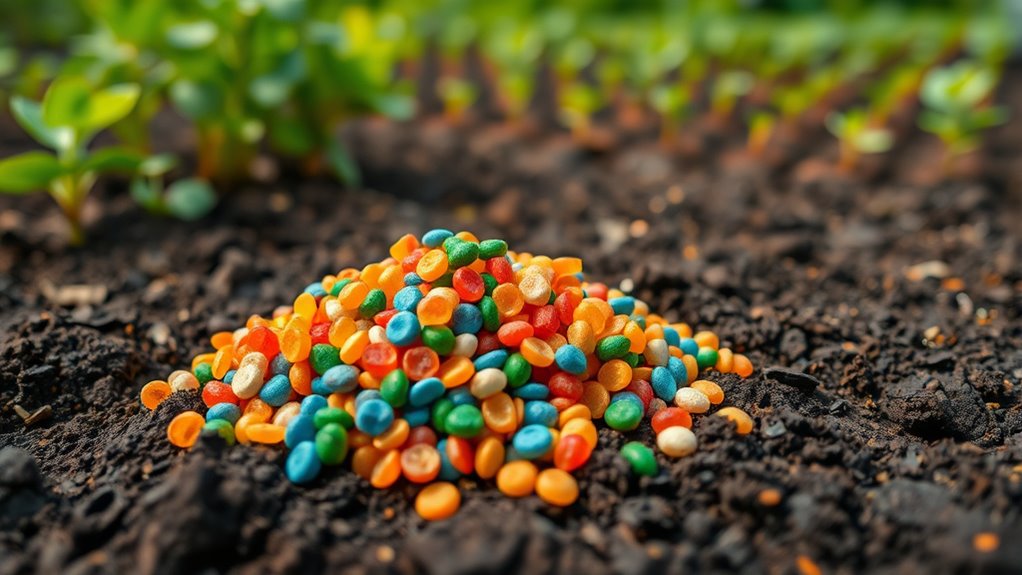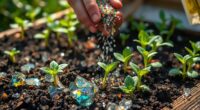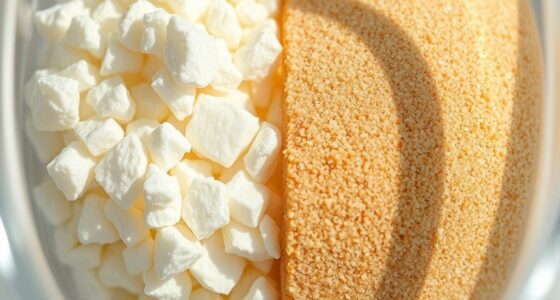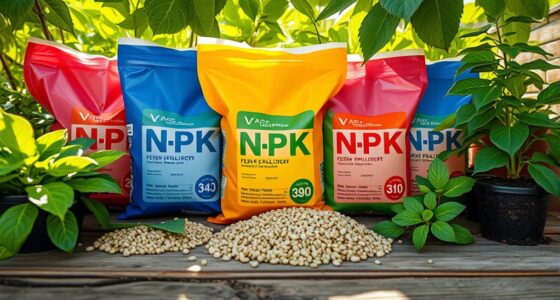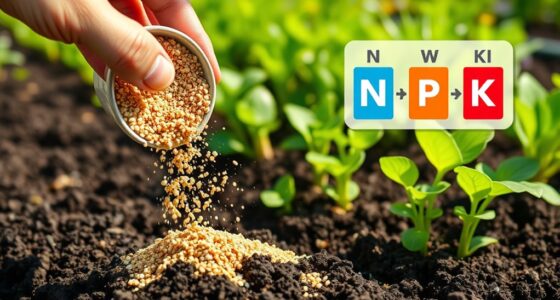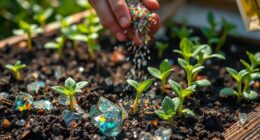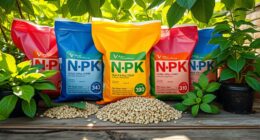Understanding N-P-K in fertilizers helps you give your plants the right nutrients for healthy growth. Nitrogen (N) promotes lush, green leaves; phosphorus (P) supports strong roots and flowering; potassium (K) boosts disease resistance and stress tolerance. Different plants and growth stages need specific ratios to thrive. Using the right balance prevents over- or under-fertilizing. Keep exploring to learn how to choose and apply the best fertilizers for your plants’ needs.
Key Takeaways
- N-P-K ratios indicate the proportion of Nitrogen, Phosphorus, and Potassium in fertilizers, guiding plant-specific nutrient needs.
- Nitrogen (N) promotes leafy growth, Phosphorus (P) supports root and flower development, Potassium (K) enhances stress resistance.
- Soil testing helps determine existing nutrient levels, ensuring proper N-P-K application for optimal plant health.
- Different plants and growth stages require specific N-P-K ratios; adjust fertilization accordingly.
- Over- or under-fertilizing can harm plants; follow recommended rates based on soil tests and plant requirements.

Ever wondered how plants grow lush and healthy? The secret often lies beneath the surface, in the soil itself. Before you start tossing on fertilizers, it’s essential to understand what your soil needs. Soil testing is your first step. It reveals the nutrient levels, pH balance, and deficiencies, helping you decide precisely what type of fertilizer to use. Without this knowledge, you might be applying unnecessary nutrients or, worse, harming your plants by over-fertilizing. Soil testing provides a clear picture, guiding you to choose the right approach, whether organic or synthetic fertilizers. Organic options come from natural sources like compost, manure, or bone meal. They improve soil health gradually, fostering a thriving microbial environment. Synthetic fertilizers, on the other hand, are chemically formulated to deliver nutrients quickly and in specific ratios. Both have their benefits, but knowing your soil’s condition helps you make an informed decision. Organic fertilizers tend to promote sustainable growth, enhance soil structure, and reduce the risk of nutrient runoff. Synthetic fertilizers offer immediate nutrient boosts, ideal for quick recovery or boosting growth during specific stages. The choice depends on your goals, plant types, and soil health, which the soil test makes clear. Additionally, understanding the self-watering plant pots can help ensure your plants receive consistent moisture, complementing proper fertilization and promoting healthy growth.
Once you’ve identified your soil’s needs, understanding the core nutrients—N, P, and K—is essential. These are the primary components in most fertilizers, often listed as N-P-K ratios on packaging. Nitrogen (N) encourages lush, green foliage and overall plant vigor. Phosphorus (P) supports root development and flowering, while Potassium (K) helps plants resist disease and adapt to environmental stresses. Knowing these ratios helps you select a fertilizer tailored to your plant’s growth stage. For example, leafy vegetables benefit from higher nitrogen, while flowering plants thrive with more phosphorus.
Applying fertilizer correctly is equally vital. Over-fertilizing can lead to nutrient runoff, environmental damage, and root burns, while under-fertilizing stunts growth. Follow the recommended application rates and timing, especially considering the plant’s lifecycle. Some plants need frequent feedings, while others require only a few applications during the season. Remember, healthy plants aren’t just about adding fertilizer—they also need proper watering, sunlight, and soil conditions. Combining these elements with a soil test ensures you’re giving your plants exactly what they need, no more, no less. With a solid understanding of soil testing and the organic versus synthetic debate, you’re well on your way to becoming a more confident gardener, cultivating vibrant, healthy plants year-round.
Frequently Asked Questions
How Often Should I Apply Fertilizer to My Plants?
You should fertilize your plants based on their specific needs and growth stage, typically every 4-6 weeks during the growing season. Keep an eye on your soil pH, as it affects nutrient absorption. Adjust your fertilizer timing accordingly—more frequent for fast-growing plants and less for slow growers. Always observe your plants for signs of nutrient deficiency, and avoid over-fertilizing to prevent soil imbalance.
Can I Use Too Much Fertilizer?
Imagine your plants as delicate dancers, and too much fertilizer as an overwhelming spotlight. Overfeeding can lead to fertilizer toxicity, where roots burn and leaves curl, signaling distress. If you notice overfeeding symptoms, reduce or stop fertilizing to prevent damage. Using too much fertilizer isn’t just wasteful—it can harm your plants, so always follow recommended guidelines. Balance is key to healthy, thriving plants, not excess.
Are Organic Fertilizers Better Than Synthetic Ones?
You might wonder if organic fertilizers are better than synthetic ones. Organic benefits include improved soil health, fewer chemicals, and better long-term plant growth. Synthetic drawbacks involve quick nutrient release, which can cause over-fertilization and environmental harm. While organic options support sustainability, synthetic fertilizers offer immediate nutrients. Your choice depends on your goals; for healthier soil, go organic, but for fast results, synthetic fertilizers work well.
How Do I Choose the Right Fertilizer for My Specific Plants?
Did you know that improper fertilizer use can reduce plant growth by up to 50%? To choose the right fertilizer, consider your plant’s specific nutrient needs, which involve understanding plant nutrient interactions. Observe your plants for signs of deficiencies. Also, select suitable fertilizer application methods, like slow-release or liquid feeds, to guarantee ideal absorption. Tailoring your approach helps your plants thrive and prevents over- or under-fertilizing.
What Are the Signs of Nutrient Deficiencies in Plants?
You might notice nutrient deficiencies in your plants through leaf discoloration, such as yellowing leaves or spots, which signals imbalance. Soil testing helps identify specific deficiencies, guiding your fertilization choices. Watch for stunted growth or poor flowering, indicating plants aren’t getting what they need. Regularly observe your plants and test your soil to catch deficiencies early, ensuring healthy, vibrant growth.
Conclusion
Think of your garden as a symphony, and fertilizers as the essential instruments. Just like a conductor carefully chooses each instrument to create harmony, you need the right N-P-K balance to help your plants flourish. When you understand what they need, you’re tuning the orchestra for a beautiful, thriving garden. So, embrace your role as the maestro, and watch your plants grow in perfect harmony, turning your space into a living masterpiece.
